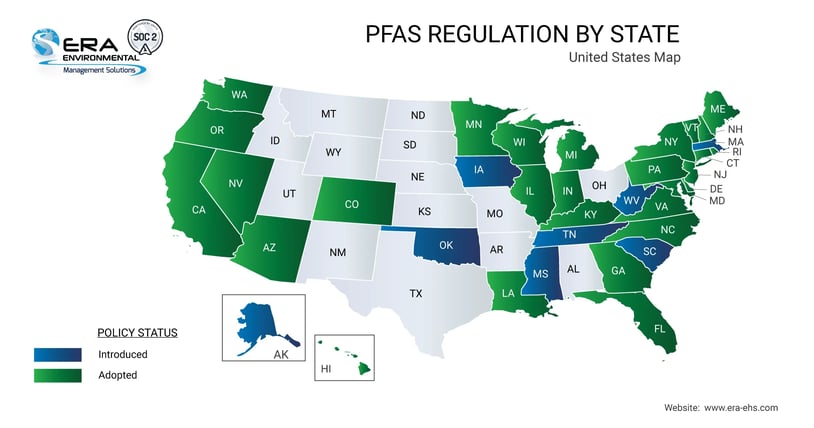Environmental reporting requirements are rapidly changing to monitor and restrict the use and release of per- and polyfluoroalkyl substances (PFAS). These compounds are found in adhesives, coatings, packaging, textiles, and more, with new regulations impacting every industry. Keeping up with these changes can pose a significant challenge for organizations of any size.
Commonly referred to as “forever chemicals,” PFAS pose severe environmental and public health concerns due to their longevity and both known and emerging harmful health effects. PFAS compose a broad category that various countries and agencies define differently. The lack of a unified definition makes reporting PFAS use even more difficult, as requirements vary for each type of report. Here are some of the latest changes to US PFAS reporting requirements.
Table of Contents
PFAS Additions to the TRI Chemical List for Reporting Year 2023
TRI Additions for Reporting Year 2024
Upcoming Removal of De Minimis Exemption for PFAS
New Analytic Methods for Clean Water Act Compliance
Backdated PFAS Reporting Requirements Under TSCA
PFAS Additions to the TRI Chemical List for Reporting Year 2023
One of the most critical environmental reporting obligations related to PFAS is the Toxics Release Inventory (TRI) under EPCRA Section 313. Organizations that manufacture, process, or otherwise use TRI-listed chemicals must file an annual report due July 1st every year.
The National Defense Authorization Act for Fiscal Year 2020 (NDAA) added 172 PFAS to the TRI-chemical list for reporting year 2020 and established a framework for future additions. Reporting years 2021 and 2022 each saw the addition of four new PFAS, bringing the total to 180.
Reporting year 2023 is no exception to this trend, adding nine new PFAS. Here are these new additions:
|
CAS Number |
Chemical Name |
|
375-22-4 |
Perfluorobutanoic acid |
|
2218-54-4 |
Sodium perfluorobutanoate |
|
2966-54-3 |
Potassium heptafluorobutanoate |
|
10495-86-0 |
Ammonium perfluorobutanoate |
| 45048-62-2 |
Perfluorobutanoate |
|
2728655-42-1 |
Alcohols, C8-16, γ-ω-perfluoro, reaction products with 1,6-diisocyanatohexane, glycidol and stearyl alc. |
|
2738952-61-7 |
Acetamide, N-[3-(dimethylamino)propyl]-, 2-[(γ-ω-perfluoro-C4-20-alkyl)thio] derivs. |
|
2742694-36-4 |
Acetamide, N-(2-aminoethyl)-, 2-[(γ-ω-perfluoro-C4-20-alkyl)thio] derivs., polymers with N1,N1-dimethyl-1,3-propanediamine, epichlorohydrin and ethylenediamine, oxidized |
|
2744262-09-5 |
Acetic acid, 2-[(γ-ω-perfluoro-C4-20-alkyl)thio] derivs., 2-hydroxypropyl esters |
Organizations must ensure they account for these new PFAS when preparing their annual TRI report for reporting year 2023. Keeping up with all the latest changes is one of the most vital best practices for TRI reporting.
TRI Additions for Reporting Year 2024
The EPA has already announced seven additional PFAS for reporting year 2024, which will affect TRI reports submitted in 2025.
|
CAS Number |
Chemical Name |
||
|
|
|
||
|
307-24-4 |
Perfluorohexanoic acid (PFHxA) |
||
|
422-64-0 |
Perfluoropropanoic acid (PFPrA) |
||
|
2923-26-4 |
Sodium perfluorohexanoate |
||
| 21615-47-4 |
Ammonium perfluorohexanoate |
||
|
82113-65-3 |
1,1,1-Trifluoro-N-[(trifluoromethyl)sulfonyl] methanesulfonamide (TFSI) |
||
|
90076-65-6 |
Lithium bis[(trifluoromethyl)sulfonyl] azanide |
||
|
2816091-53-7 |
Betaines, dimethyl(.gamma.-.omega.-perfluoro-.gamma.-hydro-C8-18-alkyl) |
Of course, it will still be necessary to review any further potential changes when the time comes to prepare that report. ERA’s TRI Reporting Software ensures that reports are complete and accurate, accounting for any and all changes.
Upcoming Removal of De Minimis Exemption for PFAS
Since their addition to the TRI-chemical list, PFAS have been eligible for the de minimis exemption. This exemption means that organizations don’t have to report TRI-listed chemicals present in mixtures or products at concentrations below 1% by weight or 0.1% for chemicals of special concern. The only PFAS with a de minimis threshold of 0.1% is perfluorooctanoic acid.
However, this will change starting reporting year 2024. The EPA has added TRI-listed PFAS to the list of Lower Thresholds for Chemicals of Special Concern. As a result, the de minimis exemption will no longer apply to any PFAS. The update also marks a significant change for any organization eligible for simplified TRI reporting using Form A. Any PFAS use will require them to report using the more comprehensive Form R.
New Analytic Methods for Clean Water Act Compliance
The impact of PFAS in waterways has quickly become one of the most significant environmental concerns today. Facilities operating under National Pollutant Discharge Elimination System (NPDES) permits must meet specific standards where approved methods exist under 40 CFR.
The Clean Water Act Methods Program has developed two new analytical methods for use in various applications, including gathering data for discharge monitoring reports (DMR) for NPDES compliance.
- Method 1633: A method to test for 40 specific PFAS compounds in wastewater, surface water, groundwater, soil, biosolids, sediment, landfill leachate, and fish tissue.
- Method 1621: A method to measure the concentration of organofluorines in waste water, a broad screening measure for thousands of known PFAS such as those found in pesticides and pharmaceuticals.
Any operations required to maintain compliance with the Clean Water Act may have to implement these new methods into their testing and reporting practices.
Backdated PFAS Reporting Requirements Under TSCA
Another major reporting requirement on the horizon for many organizations is the new rule under the Toxic Substances Control Act (TSCA) concerning backdated PFAS reporting. TSCA Section 8(a)(7) establishes a one-time requirement for organizations of any size to report information regarding PFAS production volumes, disposal, exposures, and hazards dating back to 2011.
This new reporting requirement applies to all manufactured or imported products, goods, or other articles that contain PFAS. There are few exemptions to this new rule. Reduced reporting options are available in some cases, such as PFAS used for research and development in quantities under 10 kilograms per year. There is no exemption for small manufacturers.
PFAS Definition for TSCA Reporting
Unlike TRI reporting, TSCA Section 8(a)(7) does not provide a simple list of reportable chemicals. Instead, it uses a structural definition. While the EPA does provide some general guidance through their CompTox database, organizations must report any chemical that has any of these three structures, regardless of whether or not it is listed:
- R-(CF2)-CF(R′)R″, where both the CF2 and CF moieties are saturated carbons
- R–CF2OCF2-R′, where R and R′ can either be F, O, or saturated carbons
- CF3C(CF3)R′R″, where R′ and R″ can either be F or saturated carbons
Penalties for failing to report PFAS could be severe, as the general TSCA enforcement rules allow for penalties of up to $46,989 per day per violation.
The new rule came into effect on November 13th, 2023. Manufacturers and importers have up to 18 months after that date to complete and submit their reports, with small manufacturers (as defined by 40 CFR 704.3) having 20 months. That means deadlines are May 8th, 2025, and November 10th, 2025, respectively, with submissions opening on November 12th, 2024.
Proposed RCRA PFAS Additions
There could be more new PFAS reporting requirements on the horizon if the EPA’s proposed additions to the Resource Conservation and Recovery Act (RCRA) come into effect. These changes may affect reporting requirements for facilities that handle hazardous waste.
The new rule would add the nine PFAS listed below to the list of RCRA hazardous constituents.
|
CAS Number |
Chemical Name |
||
|
|
|
||
|
335-67-1 |
Perfluorooctanoic acid |
||
|
1763-23-1 |
Perfluorooctanesulfonic acid |
||
|
375-73-5 |
Perfluorobutanesulfonic acid |
||
| 13252-13-6 |
Hexafluoropropylene oxide-dimer acid |
||
|
375-95-1 |
Perfluorononanoic acid |
||
|
355-46-4 |
Perfluorohexanesulfonic acid |
||
|
335-76-2 |
Perfluorodecanoic acid |
||
|
307-24-4 |
Perfluorohexanoic acid |
||
|
375-22-4 |
Perfluorobutanoic acid |
However, this rule is not final yet. The EPA published the proposed rule on February 8th, 2024, with the public comment period ending on April 8th, 2024.
State PFAS Regulations
Many states have PFAS regulations that restrict or outright ban their use in specific products. This is particularly common for the use of PFAS in firefighting foam, cookware, food packaging, and children’s products. Other bans extend to focus on carpets, fabrics, and other textiles.
Some states also have regulations requiring PFAS reporting, even in unrestricted applications.
- Vermont includes PFAS in its enhanced reporting requirements for children’s products.
- Minnesota currently has PFAS reporting requirements in progress expected for 2026.
- Maine has enacted a regulation that establishes reporting requirements starting with reporting year 2025.
In total, 28 states have already adopted some form of PFAS regulation, while an additional eight have introduced regulations.

Understanding any given state’s PFAS reporting requirements is essential to maintaining compliance with all applicable regulations.
Taking a Proactive Approach to New Reporting Requirements
While PFAS are a significant regulatory focus today, they are far from the only type of chemicals to face new reporting requirements. Organizations throughout all industries must ensure that they keep up with changing reporting requirements every year, and those changes often run far deeper than simple additions to existing chemical lists.
Reviewing every new environmental regulation to assess its potential impact simply isn’t possible for many organizations and isn’t the best use of time, resources, and expertise for other teams. ERA’s Environmental Management System can effortlessly track chemical usage through the year, calculate emissions and releases, and generate over 400 built-in reports to handle any compliance needs.
The regulatory experts at ERA maintain a comprehensive Master Chemical List (MCL) with up-to-date regulations for over 216,000 chemicals. This ensures that generated reports include all reportable chemicals under EPA, state agency, and other requirements. ERA’s clients save time and costly fines and penalties by leaving reporting requirements to the experts.
Are you sure your chemical tracking and reporting align with the latest regulatory requirements? Let us know if you have any questions about PFAS and chemical compliance, and consider booking a discovery call with one of our project analysts to learn more about ERA’s reporting solutions today.
Contributing Scientist of This Article:


April 9, 2024
Comments